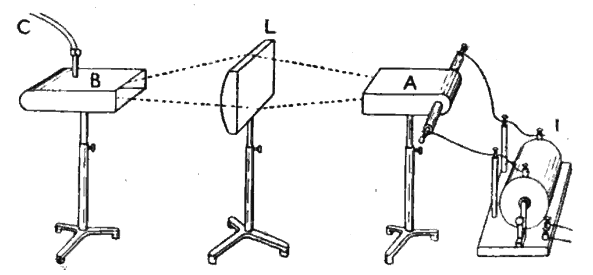Image: Refraction of Hertzian waves by a paraffin lens 1897
Description: Early experiment demonstrating refraction of microwaves by a paraffin lens, by John Ambrose Fleming in 1897, repeating similar earlier historic experiments around 1894 by Jagadish Chandra Bose, Oliver Lodge, and Augusto Righi. A spark gap transmitter A, consisting of a dipole antenna made of two brass rods with a spark gap between them inside an open waveguide, powered by an induction coil I generates a beam of microwave radio waves at a frequency of 1.5 GHz (20 centimeters wavelength). This is focused by the solid paraffin lens L on a dipole receiving antenna in the box B and detected by a coherer receiver, which rang a bell every time the transmitter was pulsed. Fleming demonstrated that the lens actually focused the waves by showing that when it was removed from the apparatus, the unfocused waves from the transmitter were too weak to activate the receiver. The historic importance of quazioptical exeriments like this is that they confirmed that radio waves and light waves are both electromagnetic waves, differing only in frequency.
Title: Refraction of Hertzian waves by a paraffin lens 1897
Credit: Retrieved 16 June 2020 from John Ambrose Fleming (1916) The Principles of Electric Wave Telegraphy and Telephony, 3rd Ed., Longmans, Green, & Co., London, p. 414, fig. 10 on Google Books
Author: John Ambrose Fleming
Usage Terms: Public domain
License: Public domain
Attribution Required?: No
Image usage
The following page links to this image:


